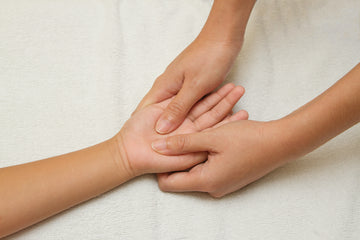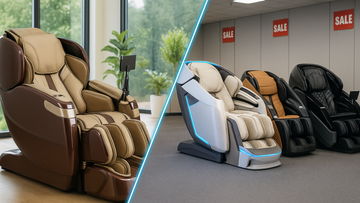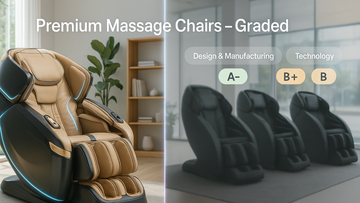When it comes to getting a massage, most people think about it as an adult self-care activity, but does it have any potential benefits for children? Our answer is a resounding yes. Children are active in their bodies and minds, making massage a welcomed and effective method for physical and mental recovery.
Today, we’re examining pediatric massage therapy, the benefits of children’s massage, and how it may improve their quality of life now and as they grow older. Learn why massage isn’t just for adults, but for people of all ages.
What Is Pediatric Massage Therapy?
Just like in adults, children’s massage, often referred to as pediatric massage therapy, is meant to improve both the mental and physical well-being of the child. This can range from anything such as behavioral conditions like excess aggression or stress through sports injury recovery and general pain relief.
Most often, children’s massage is considered a complementary therapeutic recovery form aimed at promoting a healthy sense of touch, teaching stress relief at an early age, and setting them up for a healthier lifestyle as they grow older.
Pediatric Massage Considerations
Because the subject is a child, there are many pediatric massage therapy considerations to address before moving ahead with treatment. Unlike adults, children may be unable or uncomfortable with vocalizing their needs or feelings, so it’s important to encourage an open dialogue about what a children’s massage is, its purpose, and a variety of factors that impact their experience.
These pediatric massage considerations should include:
- Age: Studies continue to be done regarding children’s massage, however, it is generally agreed that young children and adolescents are generally safe to undergo a massage experience. At younger ages, pediatric massage is more akin to touch therapy.
- Health conditions: Any underlying health conditions the child may have should be taken into consideration before getting a children’s massage. This should identify any potential pain points, disabilities, or conditions that may influence the massage techniques used.
- Personal comfort levels: It’s crucial that children be aware of speaking up about their personal comfort levels during a children’s massage. This can include how much pressure is applied, particular movements or techniques used, as well as comfort with a massage therapist.
- Physical development: Children are smaller than adults, and require a different approach for pediatric massage. The applied pressure is typically lighter and children’s massage techniques are more therapeutic in nature versus deep tissue and other types of massage adults may opt to experience.
- Mental health: Children’s massage may be used as a form of treatment for stress, aggression, ADHD, or other behavioral conditions. It’s important to analyze the child’s mental health before undergoing a children’s massage to ensure they’re aware of the process and comfortable.
- Consent: Whether it’s an adult or children’s massage, consent is always required. Before a massage therapist should begin any pediatric massage, they should speak to both the child and parent regarding consent.
Before beginning any form of children’s massage therapy, consult their pediatrician for guidance and to ensure it’s safe to do so.
Children’s Massage Techniques
Unlike in adults, children’s massage techniques don’t often reach the realm of deep tissue massage. Instead, there is a focus on therapeutic movements that stimulate physical and mental healing. You can expect children’s massage techniques to include long, gentle strokes to manipulate muscles and calm the child down. It’s an ideal environment to help them let go of stress and anxiety as well as promote bodily healing and pain relief.
There are additional children’s massage techniques that have nothing to do with how a massage therapist touches them but rather the experience as a whole. Children require much more attention and stimulation to keep them occupied while a therapist works. Many massage therapists have turned to children’s massage techniques that include telling stories or providing the child with a toy to play with while they lie down.
Children’s massage is a very different experience than that of an adult. Instead of a tranquil, quiet environment, many children respond best when essentially distracted during their pediatric massage. The touch itself is meant to facilitate the positive benefits of children’s massage more than the environmental factors. That said, it’s important to create an environment in which the child feels comfortable so they’re not intimidated or scared.
Benefits of Children’s Massage Treatment
The benefits of children’s massage treatment are still being studied, but experts believe there are a plethora of potential advantages it may provide. These range from physical wellness to mental health improvements, as well as treating a variety of conditions the child may have.
Some of the ways children’s massage may impact their overall wellness include:
- Promoting growth and development: Most specifically in babies and very young children, there have been studies that showed children’s massage may stimulate growth and development for preterm births and low-weight children. It is thought that pediatric massage therapy may also prevent future growth complications in these children.
- Alleviating stress and anxiety: Children experience stress and anxiety, too. Therapeutic children’s massage techniques may help calm their minds and help them relax. This is important as it also instills positive ways to manage stress at a young age, developing healthy habits early in life.
- Treating ADHD symptoms: Pediatric massage therapy may complement ADHD treatments as slow, gentle touch stimulates children’s mental receptors in a way that is calming and regulates their heart rate and cortisol levels. It may help boost their ability to remain calm or concentrate better.
- Complementing autism therapies: For children with autism, pediatric massage may complement other forms of therapy by providing proprioceptive input. This helps regulate their sensory system and is a non-verbal way to create connection and bonding.
- Relieving pain and soreness: Just like adults, kids can be stiff, sore, or even experience chronic pain. Children’s massage focuses on therapeutic movements and techniques to help relieve that pain.
- Reducing aggression: A recent study showed a reduction in aggression and enhancement in academic performance in elementary school kids after 10 sessions of children’s massage. Aggressive behavior in children is a concern and should be treated as best as possible early on in their life.
- Improving sleep quality: Children’s massage may improve sleep quality by regulating sleep-inducing hormones.
Children’s Massage Therapy Alternatives
When it comes to touch therapy and children’s massage, some children simply aren’t comfortable with the experience. While it may be useful for a variety of health and wellness treatments, children may not be receptive to a stranger touching them or even scared. There's a special consideration for parents using pediatric massage to help children with autism who may be sensitive to touch.
Instead of a traditional massage therapist, even one trained in children’s massage, many parents benefit from turning to a luxury massage chair instead. Massage chairs with body scanning technology ensure the massage program begins at the appropriate level for the child’s height and advancements in technology have eliminated the primary differences between using a massage chair vs human massage.
Luxury massage chair features like heat therapy and zero gravity reclining capabilities further enhance the children’s massage experience, elevating the healing and calming touch they experience. With help from an adult, one can select an appropriate massage program like Swedish massage, and choose the proper intensity level.
The lack of personal touch from another person may be beneficial for children sensitive to physical contact. Furthermore, the benefits of owning a massage chair at home include not having to maintain regular appointments with a massage therapist. Instead, you can maintain direct control over your child’s pediatric massage and provide the experience whenever it’s needed.
Massage isn’t just meant for adults. Children’s massage may provide a wide variety of physical and mental health benefits to kids of any age. Whether it’s for pain relief, faster healing, stress management, or as a complementary therapy for underlying conditions, the positive impact of pediatric massage therapy is far-reaching. Consult your child’s pediatrician and see how children’s massage may help instill healthy habits and improve their life.
Interested in experiencing the benefits of massage therapy at home? Compare massage chair models and see which is right for you and your family.





